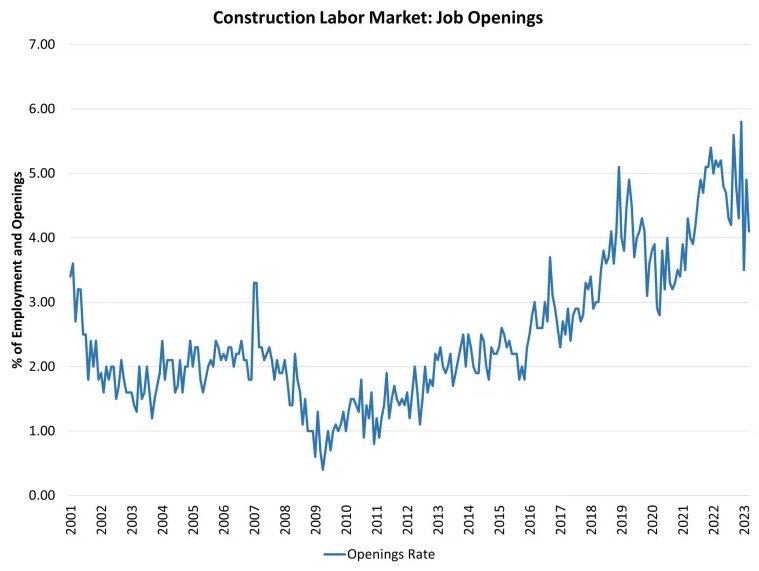Construction Job Opening Rate Continues Rollercoaster
Originally Published by: NAHB — May 2, 2023
SBCA appreciates your input; please email us if you have any comments or corrections to this article.
The count of open, unfilled jobs for the overall economy declined again in March, falling to 9.6 million, after an 11.2 million reading in December, which was the highest level since July. The count of open jobs was 12 million a year ago in March 2022. The count of total job openings should continue to fall in 2023 as the labor market softens and the unemployment rises. From an inflation perspective, ideally the count of open, unfilled positions slows to the 8 million range in the coming quarters as the Fed’s actions cool inflation.
While higher interest rates are having an impact on the demand-side of the economy, the ultimate solution for the labor shortage will not be found by slowing worker demand, but by recruiting, training and retaining skilled workers.
The construction labor market saw a decline for job openings in March as job openings in the sector trend lower. The count of open construction jobs decreased from a revised reading of 404,000 in February to 341,000 in March. This came after a data series high of 488,000 in December 2022. The overall trend is one of cooling for open construction sector jobs as the housing market slows and backlog is reduced, with a notable uptick in month-to-month volatility.
The construction job openings rate decreased to 4.1% in March. The recent trend of these estimates points to the construction labor market having peaked in 2022 and is now entering a cooling stage as the housing market weakens.

Despite the weakening that will occur in 2023, the housing market remains underbuilt and requires additional labor, lots and lumber and building materials to add inventory. Hiring in the construction sector increased to a solid 5.1% rate in March. The post-virus peak rate of hiring occurred in May 2020 (10.4%) as a post-covid rebound took hold in home building and remodeling.
Construction sector layoffs jumped to a 3.7% rate in March, consistent with an increase in volatility. In April 2020, the layoff rate was 10.8%. Since that time, the sector layoff rate has been below 3%, with the exception of February 2021 due to weather effects. The layoff rate increasing above 3% in March matches the recent trend for a weakening of construction job openings.
Looking forward, attracting skilled labor will remain a key objective for construction firms in the coming years. While a slowing housing market will take some pressure off tight labor markets, the long-term labor challenge will persist beyond the ongoing macro slowdown.
